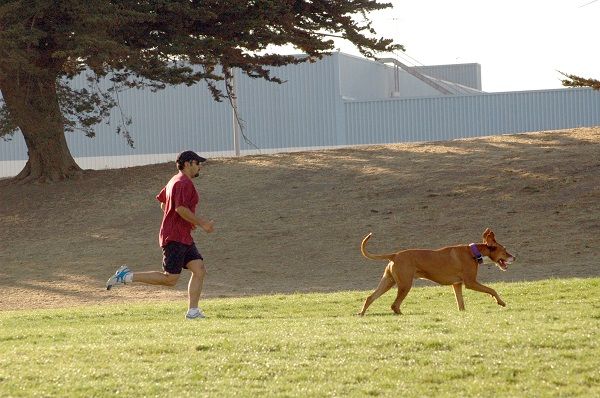There are several words that will instantly rouse our three Rhodesian Ridgebacks from even the deepest of sleeps. “Breakfast,” “cookie,” “dinner,” and “out” all result in Aero, Opus, and Amber running enthusiastically toward the kitchen for food or toward the door to be let out in the yard.
But there is one magic word that far exceeds the impact of all others: RUN. Saying the “r” word in the Sarubin household results in sheer pandemonium with three big brown dogs frantically campaigning themselves to be “the chosen one” that day. Forget actually saying a word about going running! These dogs know the difference between running shorts and regular shorts, running tights and pantyhose, or running shoes and hiking boots. Simply putting on a headband sends them into a frenzy.

My running partners for 14 of my 18 years of running have been dogs. In my experience, dogs are, by far, the best running partners. They will run any distance, anywhere at any time, and are always happy about running. They never complain about the weather, let me choose the route, allow me to set the pace and distance, and motivate me to run on an almost-daily basis – more than any human running partner ever could.
If you own an athletic dog and are a runner already, or are considering beginning a running program, you have the best of all running partners already living with you.
Why run with your dog?
Dogs love to run. They were born to run. Running will help maintain your dog’s weight, improve muscle tone, maintain a strong cardiovascular system, and build endurance. Running uphill develops rear drive. If you compete in any sort of showing or sport with your dog, he will undoubtedly be better conditioned from running than his “weekend warrior” competitors. Running is also beneficial to your dog’s mental health.
Running makes dogs happy. It allows them to explore the world through sights, sounds, and smells. They get to spend more time with you doing something fun. It allows them to release energy, making it less likely that they will vent their energy in destructive ways. This will make you happy.
Before you get started
Our dogs usually visit the vet far more often than we visit our doctor. Your dog should be examined by your veterinarian and cleared to start a running program before you subject him to many miles. If you are just beginning running yourself, it is advisable to also have a physical examination by your doctor.
How old should your dog be before it is physically safe to begin running together? One rule of thumb is that the dog’s bone growth plates should be closed before the dog takes part in any sort of rigorous activity. Some breeds and types mature more slowly than others. Owners of large dogs such as Great Danes and Scottish Deerhounds, for example, may be well advised to wait until their dogs reach the age of 1 ½ to 2 years. Lighter-boned dogs such as Miniature Pinschers and Whippets may be ready at 8 months to a year. Most dogs should be in the 1- to 1½-year range; check with your veterinarian for information on when your dog’s bone growth plates should be expected to close.
For puppies younger than these recommended ages, free play with other dogs or people is the safest form of exercise. Puppy bones and muscles need sufficient time to develop fully and may be injured by beginning a structured running program too early.
Before you begin running with your dog, it is necessary he understands and responds to basic training cues. Your dog should already be trained to walk on-leash without forging ahead and pulling you off balance, and should sit by your side when you stop at busy intersections. Teaching simple behaviors such as “slow” or “back” when your dog pulls, or “no” when he spots a squirrel or rabbit, are imperative for your safety when running. Remember, unlike walking, only one of your feet is in contact with the ground when you are running, making your dog’s sudden pulls especially dangerous.
While you will need to invest in some properly fitting, quality running shoes, and perhaps some specific running attire for yourself, running gear for your dog is simple and inexpensive. All you need is a four-foot to six-foot leather or cotton web lead and a snugly fitting flat collar to keep your dog safely by your side. A flat collar, martingale collar, or head halter are all choices to consider. A harness is also an option, but may cause chafing on longer runs. Retractable leads are not recommended.
Ready, set, go!
Many of the same principles that apply to beginning a running program for humans apply to our dogs as well. Owners and dogs should ease gradually into a running program, beginning with alternating walking and running for brief periods (no more than 20 minutes), three times a week, gradually increasing the running. Humans and dogs new to running might begin with two minutes of running at a comfortable pace followed by two minutes of walking, for a week or two. Progress to four minutes of running, two minutes walking, then to six minutes running, two walking, until you and your dog are able to run continuously for 20 minutes comfortably, three times a week.
Begin all workouts with a warm-up period of brisk walking or easy jogging before running as well as a similar cool-down after your workout.
Rest and recovery are essential to improve the fitness of both you and your dog. When just starting out, run with your dog every other day, rather than on successive days, allowing time for muscle recovery and to avoid injury while building endurance.
After four to six weeks of training three times a week for 20 minutes, both you and your dog will have built up your strength and endurance to begin to increase your mileage. The generally accepted guideline on increasing running mileage is not to exceed a 10 percent increase (in either time or mileage) a week. As you increase your mileage, your dog’s pads will gradually toughen to handle the longer distances.
How far, long, and often?
As your dog’s strength and stamina increase, he will undoubtedly delight in accompanying you on longer training runs. The number of miles, minutes, or hours you eventually run with him is largely determined by the dog. Many breeds are capable of running 25 to 35 miles a week, but perhaps individual dogs within the breed are not. It is important for you to determine your dog’s limits when running. The dog’s age, size, body density, coat thickness, and temperament may affect how far your dog can safely run. Dogs, like humans, have physical and mental differences that influence performance. By observing your dog’s behavior it is simple to figure out your dog’s comfortable running distance.
Most dogs are eager and excited at the beginning of a run with their owner, bouncing and running slightly ahead. A mile or two into the run, the dog settles into a pace with his human partner, running easily and comfortably by her side. A couple of more miles and the dog may begin to run a few paces behind the owner, and lacks his initial enthusiasm. Certainly if the dog is panting excessively, breathing fast and hard, lagging behind the length of the lead, or showing signs of lameness, it is time to abandon your training run. The signs that your dog is tiring are often subtle, and his devotion to you may cause him to run longer or farther than he would on his own. It is up to you to recognize these subtle signs and to stop your run as soon as you become aware of them.
Be particularly aware of the behavior of the older dog when running. These veterans have not lost their enthusiasm, but just as older human athletes, they need to slow down a bit and need more time for rest and recovery.
You also may look to your dog for clues to how often to schedule your training runs. Once you and your dog have been training together three times a week for several months, you may want to add another day or two (or three) to your schedule.
Running on consecutive days is not a problem for younger, healthy, athletic dogs, as long as the workouts are not successively intense. If you run a hard, fast, five-mile run on Tuesday, an easy four-mile recovery run would be perfect on Wednesday. A longer run, say 10+ miles, on Saturday, should be followed by a slow, comfortable three-mile run on Sunday. If your dog shows any signs of muscle soreness after longer or faster training runs, or lacks his usual enthusiasm for going out running, it is time to take a day off or to go for an easy walk.
What if you have a well-conditioned coursing hound, who competes on the coursing field every weekend? The goal here is to maintain his fitness, without working him to the point of injury or fatigue. Consider the following schedule: Monday: 3 mile recovery run (easy pace); Tuesday: off (or walk); Wednesday: 5 to 10 mile tempo run (a bit faster); Thursday: off (or walk); Friday: 3 to 5 mile easy run. If you like to run more than three days a week, you may just want to leave that canine athlete at home. Although he will undoubtedly be distraught when you lace up your running shoes and head out the door without him, rest and recovery are as important in a conditioning program as is the activity itself.
Running conditions
“Real” runners are not deterred by a little heat and humidity, blistering sun, cold, rain, sleet, or snow. But even if you can physically tolerate any of these conditions, your dog may not fare as well.
Heat and humidity: Some breeds tolerate high temperatures better than others, but caution should be taken with all breeds when the mercury rises. Dogs do not tolerate heat and humidity as well as humans and can easily suffer from heatstroke when running during the summer months.
Schedule your runs early in the morning or later in the evening, avoiding the highest temperature and strongest sun of the day. Choose shaded routes on warm days, avoiding direct sunlight and hot pavement that can burn your dog’s pads. Both you and your dog need to stay hydrated on your runs, especially in warmer, more humid conditions; carry a water bottle (thirsty dogs are easily trained to drink from bottles), or plan a route that includes several water stops.
Most importantly, be aware of the signs that your dog may be overheating to avoid heatstroke. Some days are simply too hot and humid for your dog to run; taking a few days off during a heat wave will not result in a loss of conditioning, and may very well save your dog’s life.
Dogs do not have sweat glands and regulate their body temperature primarily by panting. In an overheated dog, panting proves insufficient to lower body temperature. Prolonged heatstroke can lead to coma, brain damage, or even death. Take extra care running with your dog on warm days, and be aware of the signs and treatment of heatstroke.
Signs of canine heatstroke:
- High temperature (105º F to 110º F)
- Fast pulse
- Excessive panting
- Deep red or blue tongue and gums
- Distressed, agitated
- Loss of consciousness
Treatment of canine heatstroke:
- Move the dog to a cool, shady area.
- Wet thoroughly with cool water to lower body temperature.
- Apply ice packs to head and between the thighs until temperature drops below 102˚F (measure with a rectal thermometer).
- Give small amounts of water or crushed ice to replace fluids.
- If the dog does not respond after 10 minutes, seek veterinary attention
Cold and wintry precipitation: Longer coats offer some protection against the cold, but short-coated breeds need some added protection when running in colder temperatures, especially when the wind-chill temperature is low. A fleece-lined coat with a waterproof outer layer will shield your dog from the cold and wind, as well as freezing rain, sleet, and snow.
Prolonged exposure to frigid temperatures may lead to frostbite of unprotected areas (ears, paws, scrotum, and tail are particularly vulnerable), so make your runs short during the extreme cold. Be careful of ice on the road; “black ice,” an invisible thin layer of ice on pavement, is especially dangerous. Ice balls may form between your dog’s toes in icy, slushy areas, so check his paws often. And the chemicals, salt, and sand used to melt snow and ice on streets and sidewalks may irritate your dog’s feet. Always inspect your dog’s paws at the end of a run and wash off his feet, legs, and underside to remove any chemicals or salt that could be harmful to your dog if swallowed.
Running surfaces may vary depending on where you run. Running in the city guarantees lots of miles on paved roads that will toughen your dog’s pads. Living in the country, you may have access to dirt roads that are kinder on the feet and joints of both you and your dog. State forests (ones that allow dogs), parks, and watershed properties around reservoirs often have more rugged hiking or mountain biking trails that offer more of a physical challenge. “Rails to Trails” linear parks may offer paved, hard-packed, or wood chip trails.
Try to vary the surfaces you run on. Even if you live in an urban or suburban area, you can get your dog off the asphalt for portions of every run. Empty school, office building, or shopping mall parking lots usually have grass around the perimeters; run around the edge of the lot as your dog runs on the grass. Incorporate city parks and cemeteries (if they don’t prohibit dogs) into your running route, so your dog can run on grass while you’re on the road. Teach your dog to hop up on the curb and run along the grass that borders some streets. Or run on the sidewalk while your dog runs along the bordering yards. Be careful, however, not to do too much running on concrete sidewalks; it is an even harder surface to run on than asphalt and will take its toll on your legs.
Considering running with your dog off-lead? Don’t, with perhaps one exception. Running a dog off-lead in anywhere but the most remote locations, far from any motor vehicles, is an invitation to disaster. No matter how well-trained your dog is, or how reliable you believe his recall to be, it only takes one squirrel, rabbit, or deer, and one car, on even the remotest of country roads, to tragically prove to you that your dog will sometimes behave on instinct. If you have access to trails in wooded areas that allow unleashed dogs, far from any roads, running with your dog off-lead is a fun and liberating experience for you both. It is not without risks, however. A dog who does not remain in eyesight of his human runner or cannot be called off prey is not a good candidate for even a remote off-lead run.
Warning: It’s fun
Running with a dog may be highly addictive. Most dogs love to run with their humans, and their joy of running is often infectious. Even when you may not feel motivated to exercise, the guilt of depriving your dog of a favorite activity is usually enough to spur you on. All three of my Ridgebacks adore running, but they show it in different running styles. Opus, nearly 12 years of age, has slowed down considerably in recent years, but still loves a short run. He’s the hunter, always alert, looking for the slightest movement in his surroundings. Amber, 4, has days when she is the perfect pacing partner, completely focused in training, and others when she simply refuses to run at all!
But it is Aero, at 9 years old, who overtly displays his happiness on every run. While running with a joyous bounce, he occasionally looks up at me with a smile and jumps up on my side as if to say, “This is so much fun! I love running with you, Mom!” I love running with you, too, Aero.







That’s a good article thank you.
My best friend is turning 8 years old this month. She still refuses to lose fetch with other dogs, sprints like cheetah, can run 8 miles, and anything thing under 8 miles on the beach is a besting me. However i am getting sad and nervous father time will come. She is on a raw diet, gets probiotics, collagen, and various joint blended supplements. Is there advice or a blueprint i should follow for her mileage on or off days? She is a working line GSD. Lean and happy as can be.